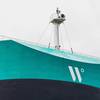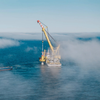Drewry Finds Risk of Carrier Failure Still High
Drewry’s Z-score carrier financial stress index sunk to its lowest ever point following the first-half 2016 results. After Hanjin’s bankruptcy shippers are demanding more financial transparency from carriers.
There is still much work to be done to clean up the logistical chaos created by Hanjin’s bankruptcy, but even so there are lessons from the sorry mess that need to be learned to avoid a repeat occurring. Firstly, all stakeholders must understand that no carrier is too big to fail. The hitherto expectation that some white knight would rescue an ailing carrier has been erased forever. Secondly, while Hanjin’s financial position was at the extreme edges and its demise is not expected to create a domino effect, a number of major carriers are still struggling and the risk of another following the same path as the Korean line cannot be discounted. Knowing these things, any company doing business with ocean carriers must undertake more due diligence than was previously the case.
During the 2008-09 industry crash Drewry initiated a Z-score freight operators’ financial stress index, which is updated in our monthly Sea & Air Shipper Insight report, to provide a quick reference to the financial fitness of selected service providers. Any reading below 1.8 indicates a higher risk of bankruptcy, which our sample of major carriers (see footnote in Figure 1 for a list of the companies used) collectively have not been able to escape from since the end of 2010. To emphasise the scale of the current financial risk the sample carriers’ average Z-score rating fell to its lowest point since the series started after the second-quarter 2016 financial statements were released.
Figure 1
Average Z-score rating of major carriers, 4Q08-2Q16 (See fig.1)
‘Note: Sample is A.P. Moller-Maersk (parent of Maersk Line), China Cosco (parent of Cosco), CSCL until 4Q15, CMA CGM, CSAV until 3Q14, Evergreen Marine Corp, Hanjin Shipping, Hapag-Lloyd, HMM, Israel Corp (parent of Zim) until 4Q14, K Line, MOL, NOL (parent of APL) until 1Q16, NYK, OOIL (parent of OOCL) half-year and annual only results only, Wan Hai, Yang Ming, Zim from 1Q15 onwards
The decline in the Z-score index has coincided with the heavy reduction in container freight rates that dropped to historical lows in the second-quarter (see Figure 2). As freight rates staged something of a recovery in third-quarter we expect to see some uptick to the Z-score when the third-quarter 2016 results are published, while the removal of Hanjin from the sample will also benefit the average score. Nonetheless, carriers will almost certainly continue to reside in the so-called “distress zone”.
Figure 2
Comparison of average Z-score risk rating of major carriers, industry average revenue per teu, 1Q13-2Q16
Source: Drewry Maritime Research (www.drewry.co.uk) – Sea & Air Shipper Insight report
Drewry consultants have met an increasingly demand from exporters and importers for carrier financial risk indicators and advice on risk management; we believe that this will lead shippers to award more volumes to those carriers who 1/ are closer to the safe zone, and 2/ provide visibility into their financial health.
The level of financial risk varies significantly between the companies in our basket of carriers. Based on the latest available financial reports the Z-score table shows that only two (A.P. Moller-Maersk and OOIL) of the 14 selected companies scored high enough to make it to the cautionary “grey zone”, with the remainder struggling in the “distress zone” (see Figure 3).
Figure 3
Extract of Z-score risk ratings of major carriers, as of 30 June 2016
Note: The full list of Z scores is available to subscribers of the Drewry Sea & Air Shipper Insight report
Source: Drewry Maritime Research (www.drewry.co.uk)
With shippers expected to pay much closer attention to the financial risks when selecting carriers in future, carriers themselves will need to be sure of the financial health of their alliance and service partners, or potentially risk losing customers. The Hanjin situation exposed many shippers who booked space from other carriers who happened to be service partners and customers are now much more aware that the risks extend beyond their own chosen service provider. Some shippers will demand that their cargo be booked on the carriers’ own ships.
Getting financial visibility is not always possible, however, as many large carriers, such as MSC and Hamburg Sud for example, do not publish their financial results. Others only report at the group level with minimal data for container operations. The demand for financial transparency is increasing and Drewry is aware that some large shippers are now requesting access to “hidden” financial information before entrusting their cargoes, in return for signing a non-disclosure agreement. As more shippers demand access to financial data during contract negotiations it will become harder for secretive carriers to hold down the drawbridge.
Financial transparency is something that carriers will need to get used to and to that end Drewry Financial Research Services has released a bespoke report, Container Shipping – A Financial Health Check – Macros and Micros that gives an independent view on the financial health of the industry and major companies. For more information please contact Rahul Kapoor, Director – DFRS at [email protected].
The report highlights how container industry debt is climbing again and that carriers do not have enough cash to meet their interest expenses (see Figure 4). Ballooning debt and negative cash flows for an extended period of time will exert serious strain on carrier business viability, which will increase the pressure on carriers to sell assets to stay afloat, or submit to a takeover.
Figure 4
Container shipping industry’s total debt (US$ billions)
Source: Drewry Equity Maritime Research (www.drewry.co.uk), Bloomberg
About the Z-score
US academic Edward Altman, using statistical analysis, developed the corporate distress Altman “Z-score” in the 1960s. Well known and respected by practitioners and academics, this score uses statistical techniques to predict a company’s probability of failure in the next two years, using data from a company’s financial statements.
The Z-score is calculated as follows:
T1 = (Current Assets-Current Liabilities) / Total Assets
T2 = Retained Earnings / Total Assets
T3 = Annualised Earnings Before Interest and Taxes / Total Assets
T4 = Book Value of Equity / Total Liabilities
T5 = Annualised Sales / Total Assets
Z-score bankruptcy rating = 1.2T1 + 1.4T2 + 3.3T3 + 0.6T4 + 1.0T5
A Z-score at or above 2.99 indicates that the company is “safe”, based on these financial figures only. A Z-score between 1.8 and 2.99 indicates that one should exercise caution (“grey zone”), based on these financial figures only. A Z-score below 1.8 indicates a higher risk of the company going bankrupt (“distress zone”), based on these financial figures only.
The Z-score company ratings shown here are objective calculations based on the well-known Z-score methodology and are provided to subscribers in good faith. They do not necessarily reflect the opinion of Drewry Shipping Consultants about the future prospects of the companies.
Drewry publishes the Z-score table – also including other freight transport companies from other sectors – in its monthly Sea & Air Shipper Insight report.
Our view
Hanjin’s bankruptcy has exposed the high level of financial risk that exists and has created renewed demand for financial transparency. Privately-owned carriers will risk losing shippers’ trust if they do not provide any data on their level of indebtedness and balance sheet strength.










